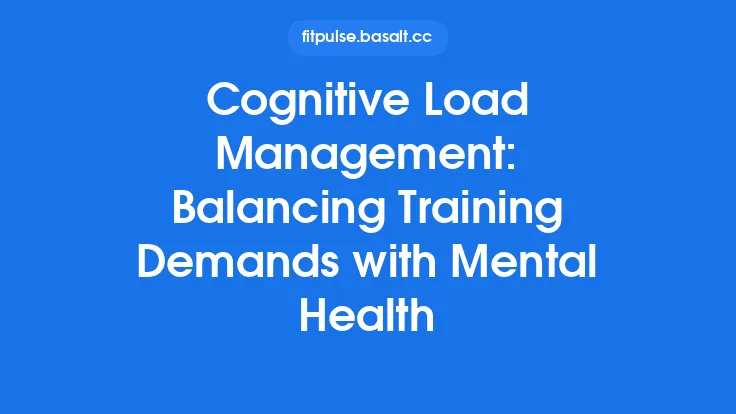The journey from a completely immobilized limb to the point where an athlete can tolerate the full spectrum of sport‑specific stresses is rarely linear. It requires a nuanced understanding of how biological tissues respond to mechanical stimuli, a systematic approach to introducing load, and vigilant monitoring to ensure that each step forward builds on a solid foundation rather than creating a new point of failure. Below is a comprehensive guide to progressive load management that can be applied across a wide range of musculoskeletal injuries, regardless of the specific sport or activity involved.
Understanding the Biological Basis of Load Tolerance
1. The Healing Cascade
- Inflammatory Phase (0‑7 days) – Cytokines and growth factors create a permissive environment for debris removal and the recruitment of reparative cells. Mechanical loading at this stage should be minimal; any stress beyond the protective splint or brace can disrupt the fragile fibrin matrix.
- Proliferative Phase (7‑21 days) – Fibroblasts synthesize collagen (predominantly type III) and extracellular matrix components. Controlled mechanical cues stimulate fibroblast alignment, improving the organization of the nascent tissue.
- Remodeling Phase (3‑12 weeks and beyond) – Collagen type I replaces type III, and the tissue undergoes realignment along lines of stress. This is the window where progressive loading can dramatically accelerate functional recovery.
2. Mechanotransduction Fundamentals
- Integrin Signaling – Mechanical deformation of the cell membrane activates integrins, which in turn trigger intracellular pathways (e.g., MAPK, PI3K/Akt) that regulate protein synthesis and cellular proliferation.
- Ion Channels & Calcium Flux – Stretch‑activated channels allow calcium influx, a key secondary messenger that influences muscle contraction strength and tendon adaptation.
- Gene Expression – Load magnitude and frequency modulate the expression of genes such as COL1A1, COL3A1, and MMPs, dictating the balance between matrix synthesis and degradation.
Understanding these mechanisms helps clinicians prescribe loads that are “just enough” to stimulate adaptation without overwhelming the healing tissue.
Phases of Load Introduction: From Immobilization to Active Loading
| Phase | Typical Timeframe | Primary Goal | Load Characteristics |
|---|---|---|---|
| Immobilization/Protection | 0‑7 days (or as dictated by injury severity) | Preserve tissue integrity, prevent further damage | No active load; passive positioning, low‑magnitude vibration (if appropriate) |
| Passive Mobilization | 5‑14 days | Restore joint nutrition, prevent adhesions | Low‑force, low‑velocity movements (e.g., pendulum swings, therapist‑guided passive range) |
| Active-Assisted Loading | 10‑21 days | Re‑engage neuromuscular pathways while maintaining protection | Light isotonic contractions (≤20 % MVC), assisted resistance bands (used only for proprioceptive cueing) |
| Early Active Loading | 2‑4 weeks | Initiate tissue remodeling under controlled stress | Sub‑maximal concentric/eccentric work (30‑50 % MVC), low‑impact weight‑bearing, controlled plyometrics (e.g., mini‑hops) |
| Progressive Functional Loading | 4‑8 weeks | Align tissue adaptation with functional demands | Incremental increases in load magnitude, velocity, and volume; introduction of sport‑specific movement patterns (without full speed) |
| Full Activity Load | 8‑12 weeks+ | Achieve load equivalence to pre‑injury sport demands | High‑intensity, high‑velocity, sport‑specific drills; load monitoring shifts to performance metrics rather than injury‑prevention thresholds |
Note: Exact timelines vary with injury type, patient age, and comorbidities. The phases above serve as a scaffold rather than a rigid schedule.
Quantifying Load: Metrics and Tools
- External Load Measures
- Weight/Resistance (kg or lbs) – Simple, objective, and universally understood.
- Volume (sets × reps) – Provides a cumulative load estimate.
- Velocity (m/s) – Particularly relevant for eccentric loading where speed influences force generation.
- Internal Load Measures
- Rate of Perceived Exertion (RPE) – A 0‑10 scale that captures the athlete’s subjective sense of effort; useful when external metrics are limited (e.g., during early passive phases).
- Heart Rate Variability (HRV) – Reflects autonomic balance; a decreasing HRV may signal excessive systemic stress.
- Muscle Oxygen Saturation (NIRS) – Offers insight into local metabolic demand during loading.
- Load‑Tracking Platforms
- Digital Load Cells – Provide real‑time force data for isometric and isotonic exercises.
- Wearable Inertial Sensors – Capture acceleration, angular velocity, and impact forces, enabling precise quantification of dynamic activities.
By combining external and internal metrics, clinicians can construct a comprehensive load profile that informs progression decisions.
Principles of Progressive Overload in Rehabilitation
| Principle | Practical Application |
|---|---|
| Specificity | Align load direction, speed, and magnitude with the functional demands of the target activity (e.g., vertical loading for jumping sports). |
| Gradualism | Increase any single load variable (intensity, volume, frequency) by no more than 10 % per week to stay within the tissue’s adaptive capacity. |
| Variability | Alternate between load types (e.g., concentric vs. eccentric) and modalities (machines, free weights, bodyweight) to stimulate different mechanotransduction pathways. |
| Recovery Integration | Pair each loading session with adequate rest (24‑48 h for moderate loads; longer for high‑intensity sessions) to allow collagen cross‑linking and muscle protein synthesis. |
| Individualization | Adjust progression based on age, hormonal status, nutrition, and prior training history; a 20‑year‑old elite sprinter will tolerate faster load increments than a 55‑year‑old recreational cyclist. |
Designing a Load Progression Framework
- Baseline Assessment
- Determine the patient’s Maximum Voluntary Contraction (MVC) for the involved muscle groups using a dynamometer.
- Establish pain‑free range of motion and joint stability thresholds.
- Set Initial Load Parameters
- Intensity: Begin at 10‑20 % of MVC for the early active phases.
- Volume: 1‑2 sets of 8‑12 repetitions, focusing on flawless technique.
- Frequency: 2‑3 sessions per week, allowing 48 h between sessions.
- Progression Algorithm
- Week‑to‑Week Increment: Add 5‑10 % MVC or an extra set, whichever yields a lower overall increase in total load.
- Load‑Shift Decision Points:
- If RPE ≤ 3 and pain ≤ 1/10 → increase intensity.
- If RPE ≥ 7 or pain ≥ 3/10 → maintain or regress load.
- Transition to Functional Loading
- Introduce multi‑joint, multi‑plane movements (e.g., lunges, step‑ups) while maintaining the 10 % weekly progression rule.
- Begin velocity‑based training once the athlete can handle ≥ 70 % MVC without pain, using a linear position transducer to monitor bar speed.
- Full Activity Integration
- Replace isolated strength work with sport‑specific drills that replicate the kinetic chain demands of competition.
- Use load‑to‑performance ratios (e.g., sprint time vs. squat load) to fine‑tune the final loading stage.
Managing Load Across Different Tissue Types
| Tissue | Load Tolerance Characteristics | Preferred Loading Modality |
|---|---|---|
| Muscle | Highly adaptable; responds quickly to metabolic stress. | Progressive resistance training (both concentric and eccentric). |
| Tendon | Slower collagen turnover; requires sustained tensile stress. | Heavy‑slow resistance (HSR) at 70‑85 % MVC, emphasizing time‑under‑tension. |
| Ligament | Relies on joint compression and shear for remodeling. | Closed‑kinetic chain weight‑bearing exercises, gradual increase in joint load. |
| Bone | Osteogenic response triggered by high‑impact, dynamic loads. | Plyometric jumps, impact loading (e.g., hopping) once sufficient soft‑tissue healing is confirmed. |
| Cartilage | Sensitive to compressive forces; benefits from intermittent loading. | Low‑impact cyclic loading (e.g., stationary bike) combined with occasional weight‑bearing. |
Tailoring the load type to the dominant tissue involved accelerates recovery while minimizing the risk of secondary injury.
Monitoring Load Adaptation and Avoiding Overload
- Weekly Load Logs – Document external load (weight, sets, reps) and internal responses (RPE, pain score).
- Trend Analysis – Look for sudden spikes in load or persistent elevation in RPE/pain; these are early warning signs.
- Recovery Metrics – Track resting HRV and sleep quality; a dip in HRV > 10 % from baseline may warrant a deload week.
- Deload Strategies – Reduce intensity by 30‑50 % for one session, or replace high‑impact work with low‑load mobility drills.
- Re‑assessment Points – Every 3‑4 weeks, repeat MVC testing and functional movement screens to verify that load adaptations are translating into performance gains.
Integrating Load Management with Nutrition and Recovery Strategies
- Protein Timing – Aim for 0.4‑0.5 g/kg of high‑quality protein within 30 minutes post‑loading to support muscle protein synthesis and collagen formation.
- Collagen Supplementation – 10 g of hydrolyzed collagen combined with 5 g of vitamin C can enhance tendon remodeling when taken around loading sessions.
- Anti‑Inflammatory Nutrition – Omega‑3 fatty acids (1‑2 g EPA/DHA daily) help modulate the inflammatory response without blunting the adaptive stimulus.
- Sleep Hygiene – 7‑9 hours of uninterrupted sleep per night optimizes hormonal milieu (growth hormone, testosterone) essential for tissue repair.
- Active Recovery – Low‑intensity cycling or swimming on off‑days promotes circulation, delivering nutrients to the healing site while keeping systemic stress low.
Common Pitfalls and How to Mitigate Them
| Pitfall | Why It Happens | Mitigation |
|---|---|---|
| Rushing the Load Increase | Athlete eagerness or external pressure to return quickly. | Enforce the 10 % weekly progression rule; use objective load logs to hold both athlete and clinician accountable. |
| Neglecting Pain as a Guide | Overreliance on performance metrics alone. | Adopt a “pain‑monitoring hierarchy” where any pain > 2/10 triggers immediate load reassessment. |
| Over‑emphasis on One Load Variable (e.g., intensity only) | Misunderstanding of the multifactorial nature of load. | Rotate focus among intensity, volume, and frequency; incorporate undulating periodization to vary stimulus. |
| Inadequate Rest Between Sessions | Misconception that “more is better.” | Schedule at least 48 h between high‑intensity loading days; use active recovery on intervening days. |
| Ignoring Tissue‑Specific Needs | Applying a generic strength program to all injuries. | Conduct a tissue‑dominant analysis early and select loading modalities accordingly (see “Managing Load Across Different Tissue Types”). |
Case Illustration: Applying Progressive Load Management
Background
- 28‑year‑old male basketball player with a grade II medial collateral ligament (MCL) sprain sustained during a lateral pivot.
- Immobilized in a hinged brace for 5 days, then cleared for passive range of motion.
Load Management Plan
| Week | Phase | Load Prescription | Monitoring |
|---|---|---|---|
| 1‑2 | Passive Mobilization | 0 kg external load; therapist‑guided pendulum swings (5 min, 3×/day) | Pain ≤ 1/10, no swelling |
| 3‑4 | Active‑Assisted | Light isotonic knee extension at 15 % MVC (2 kg), 2 sets × 10 reps, 3 ×/week | RPE ≤ 3, pain ≤ 2/10 |
| 5‑6 | Early Active Loading | Closed‑kinetic chain squat to 45° (30 % MVC), 3 sets × 8 reps, 2 ×/week | RPE 4‑5, HRV stable |
| 7‑8 | Progressive Functional Loading | Lateral lunges with 10 kg dumbbells (40 % MVC), 3 sets × 6 reps, 2 ×/week; add 5 m lateral hops (low impact) | Pain ≤ 2/10, RPE ≤ 5 |
| 9‑10 | Full Activity Load | Unrestricted basketball drills, including cutting and jumping; monitor load via wearable inertial sensors (peak ground reaction forces) | No pain spikes, RPE 6‑7, HRV within baseline |
Outcome
- By week 10, the athlete demonstrated symmetrical valgus stability on instrumented laxity testing and returned to full‑court practice without pain.
- The systematic load progression prevented a common complication—secondary ligament laxity—by ensuring adequate tensile stress during the remodeling phase.
Key Takeaways
- Load is the therapeutic agent; its magnitude, timing, and type dictate whether healing tissue adapts or regresses.
- Progressive overload must be disciplined—incremental, tissue‑specific, and guided by both objective metrics and subjective feedback.
- Monitoring is continuous; weekly logs, periodic re‑testing, and recovery markers (HRV, sleep, nutrition) form a feedback loop that safeguards against overload.
- Integration matters; optimal load management works hand‑in‑hand with nutrition, sleep, and active recovery to create an environment where the body can rebuild stronger.
- Individualization is non‑negotiable; age, sport demands, injury severity, and personal recovery capacity all shape the load progression blueprint.
By adhering to these principles, clinicians and athletes can navigate the delicate transition from immobilization to full‑activity performance with confidence, minimizing setbacks and maximizing long‑term resilience.





